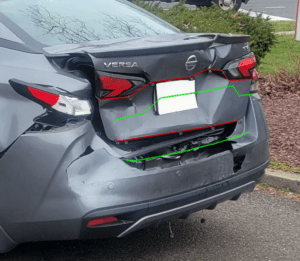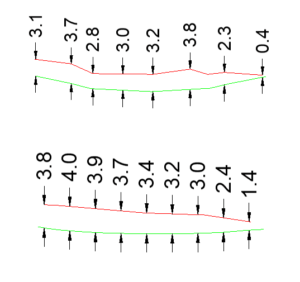A vehicle stopped at a red light was involved in a rear-end collision with another vehicle. The driver of the stop vehicle claimed multiple injuries, including some that would be difficult to attain in this type of collision. ARCCA was asked to evaluate the incident and determine the probability of the injuries claimed. The case was complicated by the discovery that no collision had been recorded on the vehicle’s Event Data Recorder.
Steps Taken:

- During their inspection, ARCCA’s team downloaded the Event Data Recorder from the sedan.
- ARCCA’s experts also reviewed the vehicle, noting that there was no evidence of seatback failure or any similar fault in the vehicle’s safety and restraint systems.
- Upon review, it was discovered that the vehicle’s EDR had not recorded a collision event.
- A photogrammetric analysis was conducted using photos from the day of the crash, to calculate the amount of crush present on the sedan.
- The crush measurements, along with variables such as the estimated weight of the vehicles, were used to estimate a delta V value of 7.5 mph for the collision.
- With the delta V value in hand, ARCCA’s biomechanists were able to evaluate the forces present in the crash.
Final Findings:

The profiles laid out, with the crush amount in inches listed. These values can be used to calculate the delta V of the crash.
Event Data Recorders are one of the best tools accident reconstructionists have for investigating a crash. Pre-impact data, such as speed, driver inputs, seatbelt use, and more help give experts a clear idea of what happened, and eliminates many variables that would otherwise be unknown. However, these systems are not without drawbacks. There are times when a collision fails to produce an event in the data recorder.
CFR Part 563, a regulation governing the requirements for Event Data Recorders, sets the threshold for triggering the system as 5 mph over a 150ms interval. However, due to the override configuration of the collision, the reinforced bumper was not contacted. Instead, the trunk lid, rear lights, and other elements of the sedan were crushed. This crush has the effect of extending the pulse and lowering the rate of acceleration imparted on the sedan. Because the speed involved in the crash were relatively low, this meant that there was not a 150ms interval where the delta V exceeded 5 mph, and thus the EDR was not triggered to record.
Fortunately, EDR data is one of several methods ARCCA has for estimating such impacts. Because good photographs were available of the sedan after the collision, the team was able to perform a photogrammetric analysis. This used the subject photos, as well as scans of an exemplar vehicle, to orient and “solve” the pictures. From there, experts could triangulate points in the photos to measure the extents of the crush present on the vehicle. From there, a crush-based analysis was able to determine a delta V value, which was then used by ARCCA’s biomechanists to demonstrate the alleged injuries could not have occurred in this collision.
